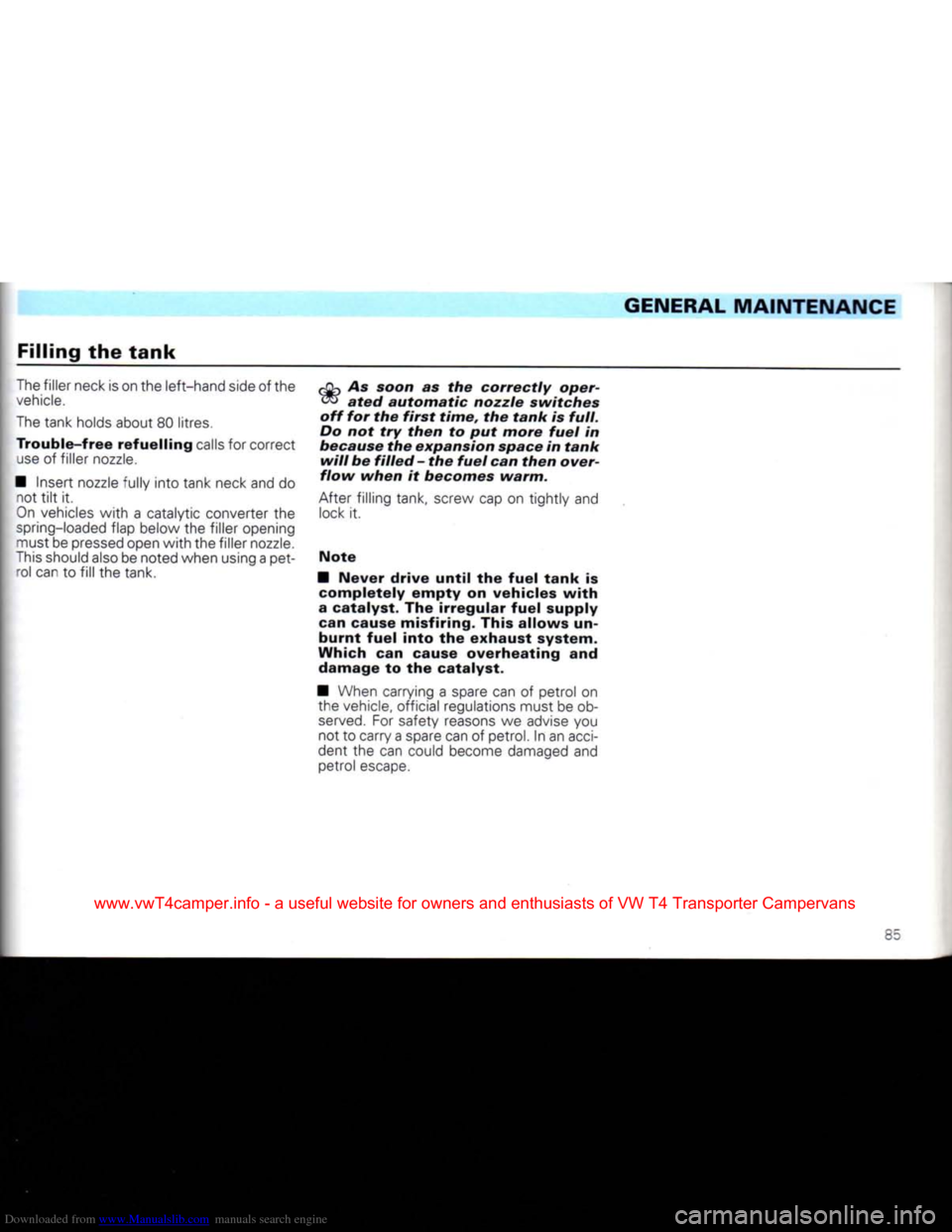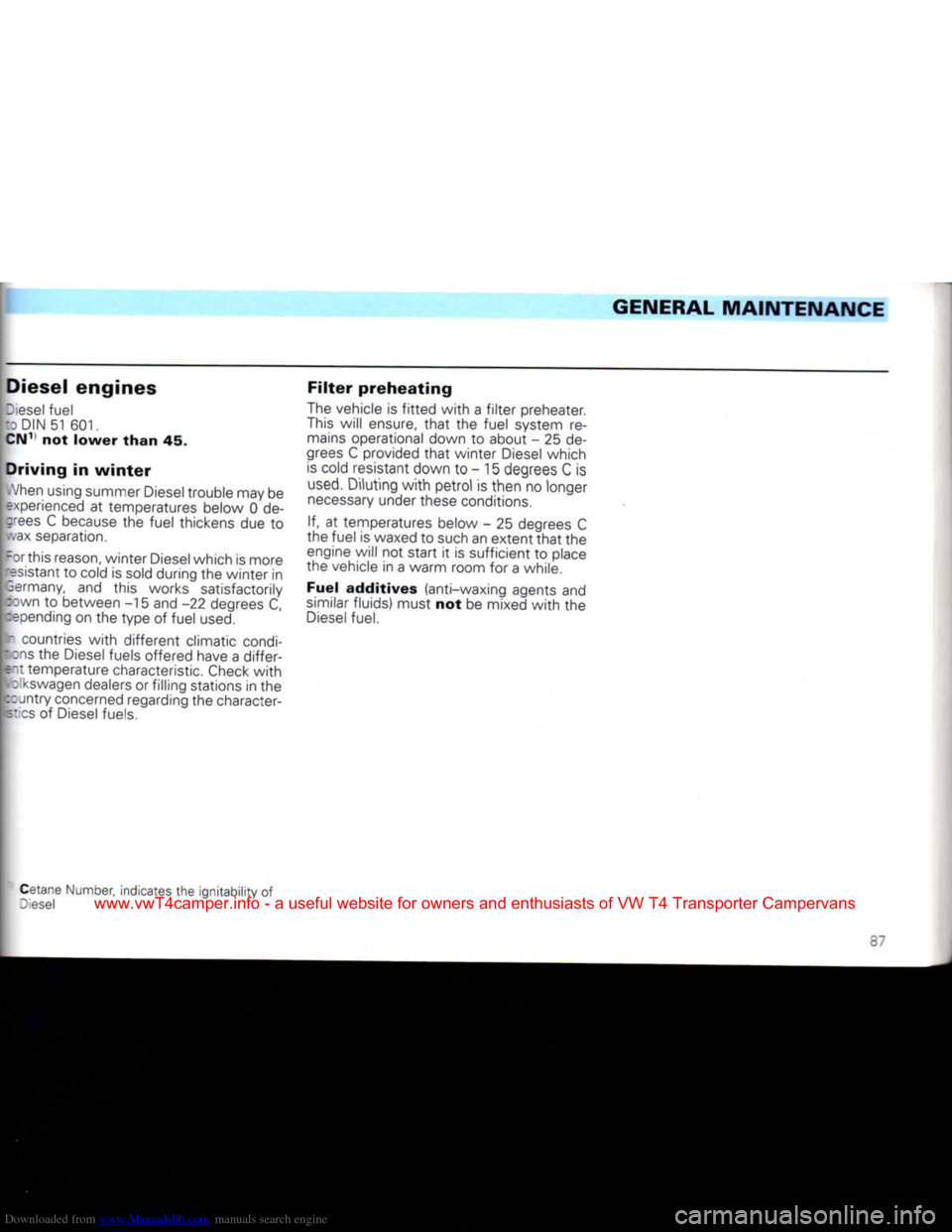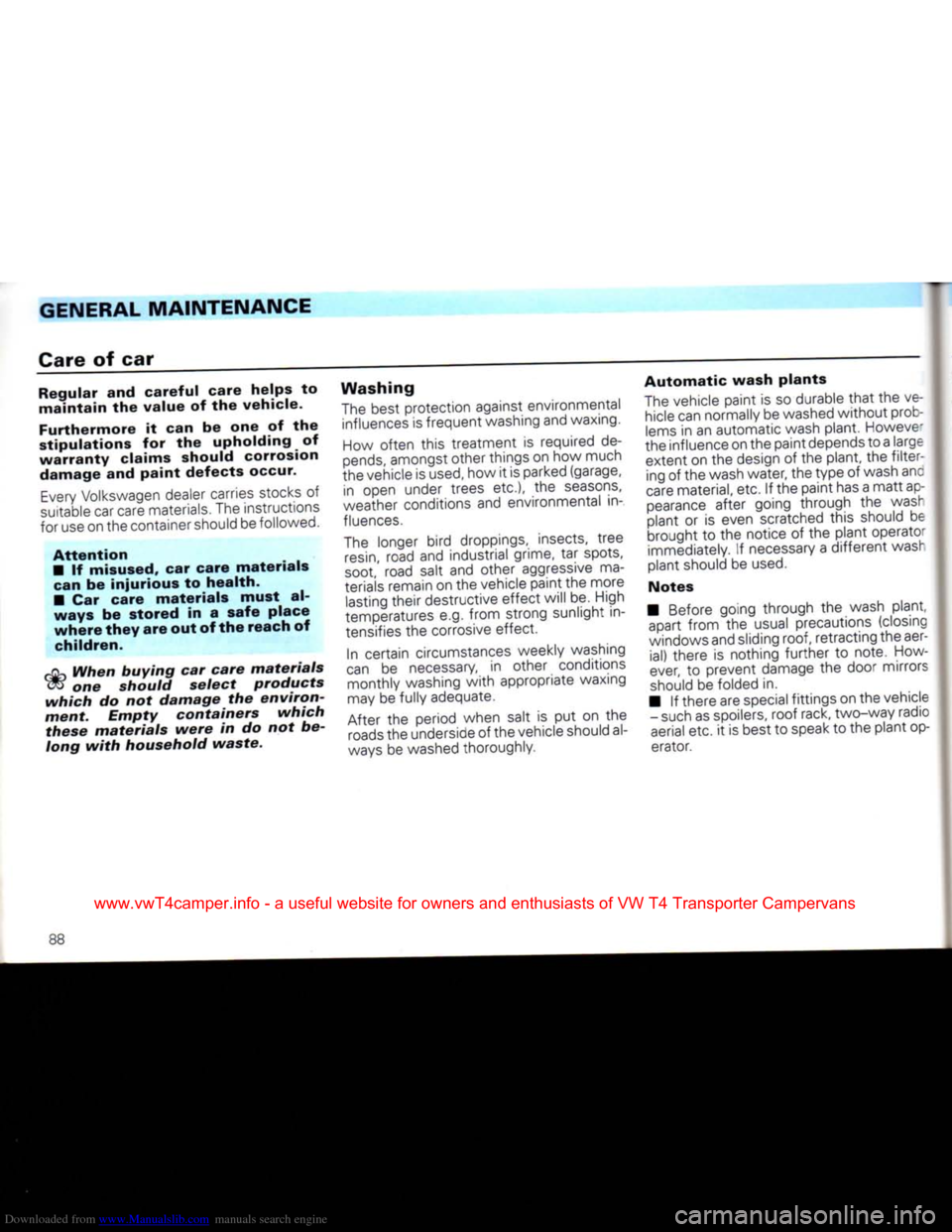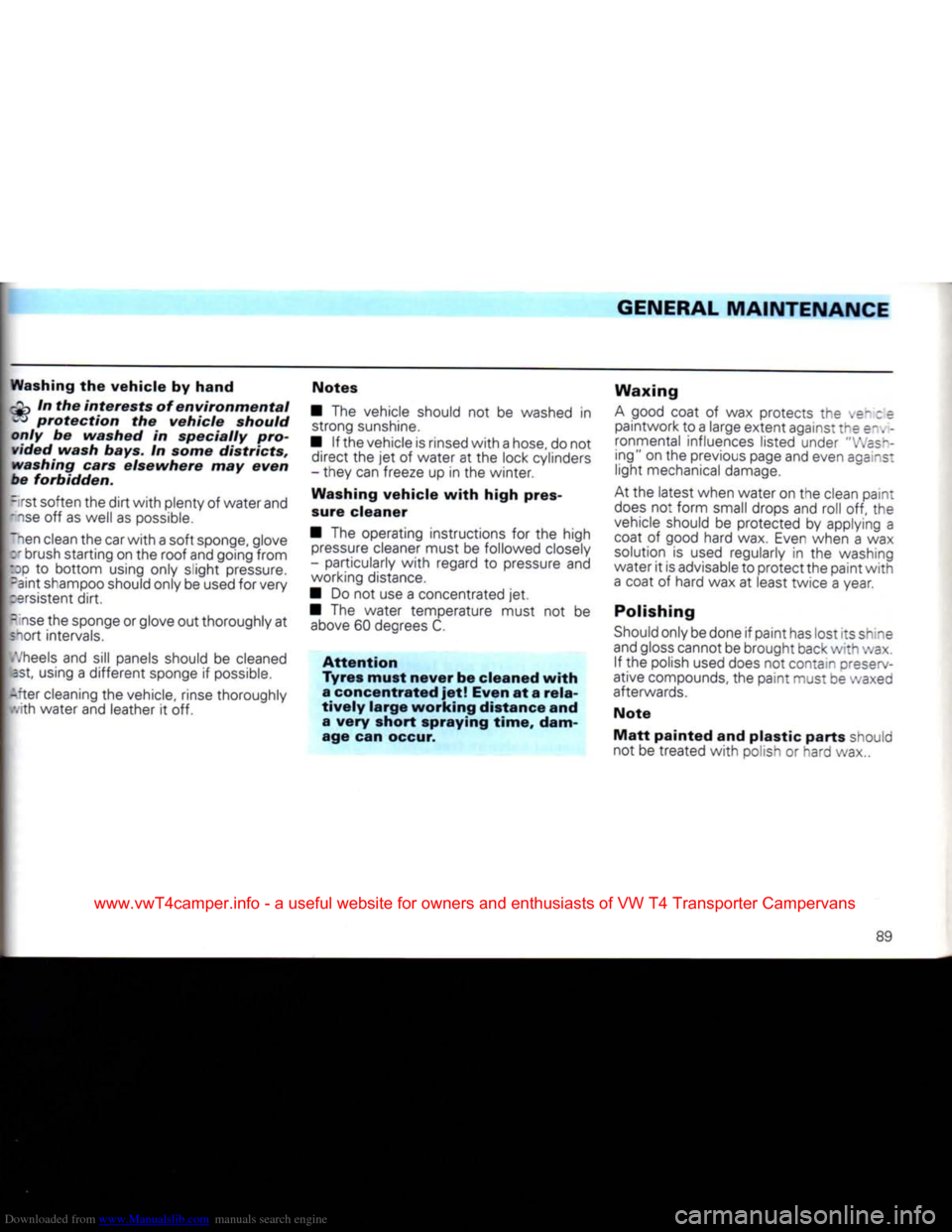1992 VOLKSWAGEN CARAVELLE maintenance
[x] Cancel search: maintenancePage 4 of 164

Downloaded from www.Manualslib.com manuals search engine
VEHICLE LITERATURE
In the vehicle wallet you will find, in addition
to this
Instruction
manual,
a Service Schedule and a Service address
list.
Also
depending on vehicle model and equip ment there can be various Supplements
(e.g.
for car radio, Multivan or Camper).
If one of these publications appears to be
missing
or you have the impression
that
the
information on some equipment or model
version is not complete, please contact your
Volkswagen
dealer. He will be pleased to help you.
You
can naturally also get in touch direct
with
our Service Department or
with
the Im porter in your country. The telephone numbers and addresses are to be found in
the Service address list.
The
Instruction
Manual
should be read carefully as soon as possible
so
that
you get to know your vehicle quickly.
Your
special attention is drawn to the
chapter "Driving tips" in this instruction
manual.
There you will see how you can
drive
safely,
economically
and envi
ronment
consciously.
For
safety
reasons
please
note
also
the
information
on Accessories,
modifications
and the
renewal
of
parts
on
page
117.
The other chapters are of course also im portant because the correct operation of the
vehicle serves - in addition to regular care
and maintenance - to maintain the value of
the vehicle and is, in many
cases,
also one of the stipulations for upholding warranty
claims.
At the end of this manual we have made a list of the checks which you should carry out
regularly to keep your vehicle roadworthy at
all times.
The Service Schedule
contains
- identification data for your car - the Service intervals
- the Service operations
- important details about Warranty
Service
work which has been carried out is
also
confirmed in the Service
Schedule.
This
can
be important when a claim is made under Warranty.
Your
should always present the Service
Schedule
when taking the vehicle to
a
Volks
wagen dealer.
The Service address
list
contains
- addresses and telephone numbers of
Volkswagen
dealers in Europe and over
seas.
- important information on the Volks wagen dealer emergency services
Notes
on the
layout
of
this
Manual:
It describes the largest possible range of
equipment envisaged at the time of going to
press.
Some of the equipment may be avail
able later on or not at all or will not be offered in certain Export markets.
Items
of equipment marked
with
a * are
only standard on certain model versions or
are only available as optional extras on cer
tain models.
All blocks of
text
which
have
this
colour
backing
and the
title
"At
tention"
refer
to
potential
acci
dent
or
injury
risks.
Texts
following
this
symbol
and
printed
in
italics
are
important
notes
on
environmental
protection.
One
final
request:
When you sell your car please give the com plete Vehicle Wallet to the new owner be
cause
the vehicle literature belongs to the
vehicle.
2
www.vwT4camper.info - a useful website for owners and enthusiasts of VW T4 Transporter Campervans
Page 5 of 164

Downloaded from www.Manualslib.com manuals search engine
CONTENTS
DASHBOARD AND
CONTROLS
Layout
4
i\='-:ng
lamps 6
CONTROLS
AND
EQUIPMENT
•
e.s. Central locking system 7, 8
I:cs, Tailgate 9, 10
I'I
~g doors 11
..
-^ows, Mirrors 12, 13
Sea: belts 15 5re:y for children 18
-ead restraints 19
Seats
20 _:ariing/sleeping surface 26
__ggage
compartment cover 27 __cgage compartment/load surface ... 28
-edals, Brakes 29 Vanual gearbox 31
--tomatic gearbox 32
gnition
lock 36
Starting / Stopping the engine .... 37, 38 "struments 40
.'.
arning lamps 47
Switches 50
~yn signal and dip lever 52
3'uise
control system 53 .'.'indscreen wiper 54
-eating and ventilation 55
Air
conditioner 57
Recirculating air switch 61
Auxiliary heater 63
Additional
water heater 67
Sun roof, Sliding/tilting roof 70, 71
nterior lights, Sun visors 72, 73
Ashtray, Cigarette lighter 73
-oof
rack 75
DRIVING
TIPS
The first 1500 km - and afterwards ... 76 Driving safely 78
Driving economically and
ecologically
79
Trailer towing 81
GENERAL
MAINTENANCE
Filling the tank, Fuel 85, 86
Care of car, Maintenance 88, 93 Bonnet, Engine compartment 94, 95
Engine oil, Gearbox oil 96, 99
Air
cleaner 100 Power assisted steering 100
Cooling
system 101
Brake fluid 104
Battery 106
Windscreen washer system 108
Wheels 110
Arduous operating conditions 115
Winter driving 116
Accessories, modifications and
renewal of parts 117
Mobile
telephones and two way
radios 117
DO-IT-YOURSELF
First
aid kit, Warning triangle 118
Vehicle tools 118 Spare wheel/changing wheel ... 119, 120
Fuses
122
Changing
bulbs 124
Adjusting/masking headlights .. 128,129
Headlights 129
Installing radio 129
Emergency starting 130
Tow starting/towing 132
Lifting vehicle 134
TECHNICAL
DESCRIPTION
Engine 136
Emission control system 137
Activated charcoal filter '38 Power flow '39
Steering, Axles 139 Brakes, Body -139,
1
AC
Environment compatibility 140
TECHNICAL
DATA
Engine 141
Performance 142
Fuel consumption 143
Spark plugs 145
V-belts 145
Wheels,
Tyre
pressures 146, 147
Weights,
Trailer weights 148, 151 Dimensions 152
Capacities 153
Vehicle identification data 154
SPECIAL
INFORMATION
Adjusting the brake pressure regulator 155
ALPHABETICAL
INDEX
Alphabetical index 156
CHECKS
WHEN
FILLING
THE TANK
Overview 160
3
www.vwT4camper.info - a useful website for owners and enthusiasts of VW T4 Transporter Campervans
Page 82 of 164

Downloaded from www.Manualslib.com manuals search engine
DRIVING
TIPS
The technical
prerequisites
"or
a low fuel consumption and efficiency were "built in" at the factory. Particular im
portance was placed on the lowest possible
disturbance
to the environment. To retain
and
make the best possible use of these
characteristics
attention should be paid to
the following points:
Vehicles
fitted
with
a
catalytic
converter
may
only
be
driven
on
unleaded
petrol.
Even
those
vehicles
which
do
not
have
a
catalytic
converter
should
be
driven
on
unleaded
petrol
for the
sake
of the
environment.
The
prescribed
maintenance
operations
should
be
carried
out
exactly
as
specified
in the
Service
Schedule - see
also
page
93.
Having your vehicle regularly serviced by
a Volkswagen dealer not
only
ensures
that
it is always operationally fit, but it
also ensures economy, lowest possible burden on the environment and a long
service
life.
Check the
tyre
pressures
every
4
weeks.
Low
tyre
pressures increase the rolling
resistance.
This not
only
increases the
fuel
consumption and
tyre
wear,
but the
handling is also impaired.
Do not
carry
unnecessary
ballast
in the
luggage
boot
Particularly in
town
traffic
when one has to accelerate
often,
weight
has a
great
in
fluence on the
fuel
consumption. As a
rule
of
thumb:
For every 100 kg of
weight
the consumption increases by approxi
mately
litre
per 100 km.
Remove
roof
rack
immediately
after
use
Particularly at
high
speeds the increased
air resistance makes
itself
felt
consider
ably.
gCK
Electrical
consumers
should
only
be
switched
on
when
they
are
actually
required
Heated rear windows, additional driving
lights
and heater blower consume a con
siderable amount of
current.
The higher
alternator
load
also increases the
fuel
consumption. For instance, over a period of 10 hours, the heated rear window
will
increase
the
fuel
consumption by ap
proximately 1
litre.
Check the
fuel
consumption
reg
ularly
The
fuel
consumption should be checked
each
time
the
tank
is
filled
up. By doing
this
inconsistencies on the vehicle which
lead to an increased
fuel
consumption
can be discovered sooner.
• Check the
engine
oil
level
each
time
the
tank
is
filled
up
The
oil consumption depends to a great ex
tent
on the engine load and
speed.
Depend
ing on the style of driving the consumption
can
be as much as 1.0 litres/1000 km.
It is normal for the oil consumption of a new
engine
to reach its lowest level after a cer
tain mileage has been covered. The
con
sumption cannot be properly
assessed
until
the vehicle has run approx. 5000 km.
This
also
applies to the fuel consumption
and
the engine output.
www.vwT4camper.info - a useful website for owners and enthusiasts of VW T4 Transporter Campervans
Page 87 of 164

Downloaded from www.Manualslib.com manuals search engine
GENERAL
MAINTENANCE
Filling the
tank
The
filler neck is on the left-hand side of the
vehicle.
The
tank holds about 80 litres. Trouble-free
refuelling
calls
for correct
use
of filler
nozzle.
•
Insert
nozzle
fully into tank neck and do not
tilt
it.
On
vehicles with a catalytic converter the
spring-loaded
flap below the filler opening
must be
pressed
open with the filler
nozzle.
This
should
also
be noted when using a pet rol can to
fill
the tank. As soon as the
correctly
oper
ated
automatic
nozzle
switches
off for the
first
time,
the
tank
is
full.
Do not try
then
to put
more
fuel
in
because the expansion space in
tank
will
be
filled
- the
fuel
can
then
over
flow
when
it becomes
warm.
After
filling tank, screw cap on tightly and
lock
it.
Note
•
Never
drive
until
the
fuel
tank
is completely
empty
on vehicles
with
a catalyst. The
irregular
fuel
supply
can cause misfiring. This
allows
un-
burnt
fuel
into
the exhaust system.
Which can cause
overheating
and damage to the catalyst.
•
When carrying a spare can of petrol on the vehicle, official regulations must be ob
served.
For safety reasons we advise you not to carry a spare can of petrol. In an
acci
dent the can could become damaged and petrol
escape.
55
www.vwT4camper.info - a useful website for owners and enthusiasts of VW T4 Transporter Campervans
Page 88 of 164

Downloaded from www.Manualslib.com manuals search engine
GENERAL
MAINTENANCE
Fuel
Petrol
engines
Vehicles
with
catalyst
62 and 81 kW Fuel
injection
en
gines
Unleaded
regular
petrol
RON11 not
lower
than
91
rQp
On
vehicles
with
catalytic
con-
<35
verter
only
unleaded
petrol
may
be
used.
The
use of leaded petrol is very detrimental
to the functioning of the emission control
system
because the lead is deposited in the
catalytic converter.
rijK
Even
one
tankful
of
leaded
pet-
®5
rol
will
detract
from
the
effi
ciency
of the
catalytic
converter.
Although unleaded fuel may again be used
afterwards the original efficiency of the
catalytic converter is never fully attained.
On
vehicles
with
Lambda probe2' the mix
ture formation is also negatively affected.
11
Octane
Number, indicates the ignitability of
Diesel
2) Lambda = Air/petrol relationship Vehicles
without
catalytic
con
verter
62 kW
Carburettor
engine
unleaded
or leaded
regular
petrol
RON1) not
lower
than
91
i-Op
In the
interests
of our
environ-
ment
unleaded
petrol
should
be
used
whenever
possible.
Notes
• Unleaded petrol must comply
with
DIN3' 51 607 and leaded petrol
with
DIN 51 600.
• Only good quality petrol containing addi tives should be used - see also" Petrol addi
tives"
next column.
• If in an emergency the octane rating of the available petrol is lower than
that
required by the engine, only drive
with
me
dium engine speeds and low engine load
ing.
High
engine
loading
with
full
throttle
or
high
revs
can cause en
gine
damage.
Fill tank
with
petrol of the
correct rating as soon as possible.
31 Standards issued by the German Standards Institution.
Petrol
additives
The
quality of the fuel has a decisive influ
ence
upon the running behaviour, perform
ance
and service life of the engine. The addi
tives which are mixed into the petrol are of particular significance. One is advised
therefore only to use good
quality
pet
rol
containing
additives.
If such fuel is not available, or if engine
troubles such as starting difficulties, stalling during idling, vibration and loss of power
occur,
the appropriate additives should be
mixed
with
the petrol when filling the tank.
At temperatures between about 0 and 15
degrees
C, these additives prevent possible icing up of the carburettor, have an anti-cor
rosion effect, clean the fuel system and pre
vent deposits building up in the engine.
Petrol
additives available in accessory
outlets have not all shown themselves to be
effective. Therefore additives which have
been
tested for
Volkswagen
engines are av
ailable
from Volkswagen dealers in
Ger
many and in many export countries. The
Volkswagen
dealers are also informed
with
regard to the use of additives, and they know what to do in
cases
where deposits
have
already built up.
SB
www.vwT4camper.info - a useful website for owners and enthusiasts of VW T4 Transporter Campervans
Page 89 of 164

Downloaded from www.Manualslib.com manuals search engine
GENERAL
MAINTENANCE
Diesel engines
Diesel
fuel
I
DIN 51 601.
CN1'
not
lower
than
45.
Driving
in
winter
When
using summer Diesel trouble may be
experienced
at temperatures below 0 de
grees
C because the fuel thickens due to
wax
separation.
Br
this
reason,
winter
Diesel
which is more
"esistant
to cold is sold during the winter in
Germany,
and this works satisfactorily
:Dwn
to between -15 and -22 degrees C,
cepending
on the type of fuel
used.
I countries with different climatic condi-
" :ns the Diesel fuels offered have a differ
ent
temperature characteristic.
Check
with ; kswagen dealers or filling stations in the
::
jntry
concerned regarding the character-
s:
cs of Diesel fuels.
Filter
preheating
The
vehicle is
fitted
with a filter preheater.
This
will ensure, that the fuel system re
mains
operational down to about - 25 de
grees
C provided that winter Diesel which
is
cold resistant down to - 15
degrees
C is
used.
Diluting with petrol is then no longer
necessary
under these conditions.
If, at temperatures below - 25 degrees C
the fuel is waxed to such an extent that the
engine
will not start it is sufficient to place
the vehicle in a warm room for a while.
Fuel
additives
(anti-waxing agents and
similar
fluids) must not be mixed with the
Diesel
fuel.
Cetane
Number, indicates the ignitability of
Diesel
www.vwT4camper.info - a useful website for owners and enthusiasts of VW T4 Transporter Campervans
Page 90 of 164

Downloaded from www.Manualslib.com manuals search engine
GENERAL
MAINTENANCE
Care
of car
Regular
and
careful
care
helps
to
maintain
the
value
of the
vehicle.
Furthermore
it can be one of the
stipulations
for the
upholding
of
warranty
claims should corrosion
damage
and
paint
defects
occur.
Every
Volkswagen dealer carries stocks
of
suitable car care materials. The instructions
for use on the container should be followed.
Attention
•
If
misused,
car
care
materials
can
be
injurious
to
health.
•
Car
care
materials
must
al
ways
be
stored
in a
safe
place
where
they
are out of the
reach
of
children.
When
buying
car
care
materials
one
should
select
products
which
do not
damage
the
environ
ment.
Empty
containers
which
these
materials
were in do not be
long
with
household
waste.
Washing
The
best protection against environmental
influences
is frequent washing and waxing.
How
often this treatment
is
required
de
pends,
amongst other things on
how
much
the vehicle is
used,
how
it
is parked (garage, in open under trees etc.),
the
seasons,
weather conditions
and
environmental
in
fluences.
The
longer bird droppings, insects, tree
resin,
road
and
industrial grime,
tar
spots,
soot, road salt
and
other aggressive
ma
terials remain on
the
vehicle paint the more lasting their destructive effect will be. High
temperatures e.g. from strong sunlight
in
tensifies
the
corrosive effect.
In certain circumstances weekly washing
can
be
necessary,
in
other conditions monthly washing
with
appropriate waxing
may
be
fully adequate.
After
the
period when salt
is put on the
roads
the underside
of
the vehicle should al
ways
be
washed thoroughly.
Automatic
wash
plants
The
vehicle paint
is so
durable
that
the ve
hicle
can normally be washed without prob
lems
in an
automatic wash plant. Howeve'
the influence on the paint depends
to
a large extent
on the
design
of the
plant,
the
filter
ing
of
the wash water, the type
of
wash anc
care
material, etc.
If
the paint has a
matt
ap
pearance
after going through
the
wash
plant
or is
even scratched this should
be
brought
to the
notice
of the
plant operate
immediately.
If
necessary
a
different wash
plant should
be
used.
Notes
• Before going through
the
wash plant, apart from
the
usual precautions (closing
windows and sliding roof, retracting the aerial) there
is
nothing further
to
note. How
ever,
to
prevent damage
the
door mirrors
should
be
folded
in.
•
If
there are special
fittings
on the vehicle - such as spoilers, roof rack, two-way radio
aerial
etc.
it is
best
to
speak
to the
plant operator.
88
www.vwT4camper.info - a useful website for owners and enthusiasts of VW T4 Transporter Campervans
Page 91 of 164

Downloaded from www.Manualslib.com manuals search engine
GENERAL
MAINTENANCE
Washing
the
vehicle
by
hand
In the
interests
of
environmental
B
protection
the
vehicle
should
only
be
washed
in
specially
pro
vided
wash
bays.
In
some
districts,
washing
cars
elsewhere
may
even
be
forbidden.
Irst
soften the
dirt
with
plenty of water and
-ise
off as well as possible.
~nen clean the car
with
a soft sponge, glove
or brush starting on the roof and going from :3p to bottom using only slight pressure. :aint shampoo should only be used for very
cersistent
dirt.
=
:nse
the sponge or glove out thoroughly at
snort intervals.
.'.'heels
and sill panels should be cleaned
last, using a different sponge if possible.
After cleaning the vehicle, rinse thoroughly
vith
water and leather it off.
Notes
• The vehicle should not be washed in strong sunshine.
• If the vehicle is rinsed
with
a
hose,
do not direct the jet of water at the lock cylinders
- they can freeze up in the winter.
Washing
vehicle
with
high
pres
sure
cleaner
• The operating instructions for the high
pressure
cleaner must be followed closely
- particularly
with
regard to pressure and working distance.
• Do not use a concentrated jet. • The water temperature must not be above 60 degrees C.
Attention
Tyres
must
never
be
cleaned
with
a
concentrated
jet! Even at a
rela
tively
large
working
distance
and a
very
short
spraying
time,
dam
age can occur.
Waxing
A
good coat of wax protects the .s~ : e
paintwork to a large extent against the e". -
ronmental influences listed under
"Wash
ing"
on the previous page and even agars:
light
mechanical damage.
At the latest when water on the clean paint
does
not form small drops and roll off, the
vehicle should be protected by applying a
coat of good hard wax.
Even
when a wax solution is used regularly in the washing
water it is advisable to protect the paint
with
a
coat of hard wax at least twice a year.
Polishing
Should
only be done if paint has lost its shine
and gloss cannot be brought back
with
wax. If the polish used does not contain preserv
ative compounds, the paint must oe waxed
afterwards.
Note
Matt
painted
and
plastic
parts
should not be treated
with
polish or hard wax..
89
www.vwT4camper.info - a useful website for owners and enthusiasts of VW T4 Transporter Campervans